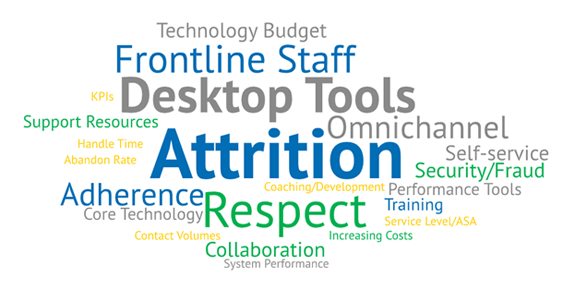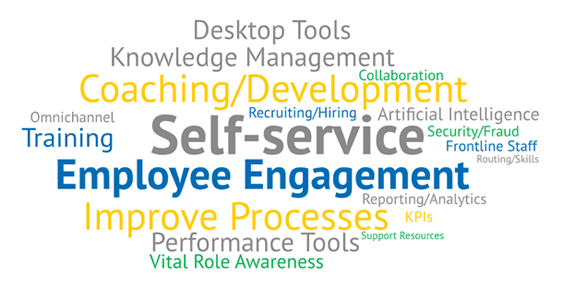It’s 2020: a new year, a new decade, and all kinds of opportunities to talk about perfect vision! Let’s start off this exciting year with a look at findings from our fifth annual survey.
Last year’s theme was change. Our 2020 theme (or vision) is “the year of the agent,” which deviates from the industry focus on improving the customer experience. Yet, as centers tackle their challenges and pursue their priorities, I believe we will see a strong focus on the agent experience, and the result should be better customer experience as well.
While I encourage you to read the full article, here are a couple of word pictures to give you a quick summary of this year’s top challenges and priorities (ranked by text size):
Challenges

Priorities

Aligning Challenges and Priorities
I think we can draw some pretty good lines between the priorities and our strong top challenge – attrition. Many things can impact attrition, and I’ve recently written about how technology can help with employee engagement. Perhaps the biggest opportunity for improvement would be a focus on engagement, coaching and development, process changes, and better use of technology. Agents want to succeed, and when they do, they feel better about their role.
The other alignment element I like and see as an improvement is the higher prioritization of raising awareness of the center’s vital role and impact. Every year the strategic challenges of lack of understanding and respect and poor cross-departmental collaboration rate higher than the corresponding action. I have hypothesized that it feels like a problem that can’t be solved. Maybe centers are finally starting to see this can be tackled and it’s worth a try.
Goals
We added a bonus question this year: “Overall, what would your CC leadership say is the most important goal for 2020?” Sixty-one percent choose improve the customer experience. Goals chosen by other included improve the agent experience (15%), reduce/manage costs (14%), and increase revenue (9%).
Here are some interesting finds and a few thoughts about the goal focus results.
With those who chose customer experience as their goal and selected Improve Self-Service as the most dominant priority, a caution is in order. That self-service pursuit better be done with a focus on the customer (e.g., careful design and testing – with real customers!) rather than to deflect live contacts or contain contacts within the apps. Yes, a good customer experience occurs when customers can succeed in self-service, but the applications also must be easy to use and easy to exit to an informed agent.
Items outside the overall top 10 that jump out for those with goals other than Improving Customer Experience are:
- Lack of support resources or know-how
- Increasing/high costs
- Lack of and/or bad core technology (routing, reporting, CTI)
- Lack of focus on coaching/development
- Lack of and/or bad performance tools (QM, WFM, analytics, etc.)
For those focused on agent experience:
- Attrition is a pain point for a high percentage (36%), as is absence/adherence (21%)
- Coaching and development and process improvement are top priorities to improve the agent experience, not self-service
- Many struggle with the lack of support resources and core technology
- Compared to the overall results, a higher percentage prioritize recruiting/hiring (19%) and performance management practices (14%); and a lower percent prioritize self-service (12%)
For those focused on reducing/managing costs:
- As expected, increasing/high costs is a big challenge for 18% of this group
- Their top priority also aligns: 26% chose “staff properly to match workload”
- Incorporating new staffing approaches also ranked high (18%)
For those focused on increasing revenue:
- This group was influenced by the BPO vertical (32% of the respondents that chose this goal), thus showing a very high percentage (52%) noting attrition as a top challenge
- They see empowerment, coaching, and knowledge management as strong tools to help them achieve their goals
- Self-service is understandably less important; rather, they are pursuing omnichannel, better hiring and staffing, and performance management to address their challenges (which include increasing/high costs for 20%)
